Satellite and Ground Observations of Snow Cover in Tibet during 2001–2015
Abstract
:1. Introduction
2. Study Area and Data
2.1. Study Area
2.2. MODIS Eight-Day Snow Products
2.3. Ground Observed Daily Snow Data
2.4. Ground Observed Monthly Precipitation and Air Temperature
2.5. DEM Data
3. Results
3.1. Snow Cover Characteristics and Variations over Tibet Based on MOD10A2 Data
3.1.1. Annual Snow Cover Frequency and Spatial Distribution
3.1.2. Spatial Distributions of Snow Cover Frequency for Different Seasons
3.1.3. Spatial Distributions of Snow Cover Frequency for Different Altitudes
3.1.4. The Variation of the Starting Times of Snow Accumulation and Ablation
3.2. Snow Cover Variations during 2001–2015 Based on Data from 37 Meteorological Stations
3.2.1. Annual Snow Cover Distribution
3.2.2. Snow Cover Distribution at the Stations at Different Altitudes
3.2.3. Changes in the Start and End Times of the Snow Season in Tibet
4. Discussion
4.1. Relationships between MODIS and Station Snow Cover
4.2. Comparison of the Interannual Snow Cover Variation Based on Eight-Day Snow Cover
4.3. Comparison of the Average Annual Cycle of Snow Cover from the Two Datasets
4.4. Comparison of the Average Annual Snow Cover at Different Altitude Ranges
4.5. Comparison of the Starting Times of Snow Accumulation and Ablation from the Two Datasets
5. Conclusions
- The spatial distribution of snow cover was very uneven. The snow cover frequency was less than 21% for 70% of the Tibetan area. In eastern Tibet and in the Himalayas, snow cover frequencies reached more than 40%. Approximately 2% of Tibet is permanently snow covered.
- The snow cover fluctuated greatly from day to day (or between periods, MODIS). The average snow cover percentage of the 687 MODIS eight-day periods was 16%. The maximum snow cover percentage was 52%, which took place in January of 2015.
- The snow cover and duration of the snow season increased with altitude. For altitudes above 6000 m, the low snow cover season is only July, but for the lowest altitudes, it lasts from May to the end of August.
- During the 15 years, both datasets revealed a significant trend of earlier onset of ablation, but no evident trend for the beginning of accumulation.
- The two datasets differed slightly with respect to the seasonal variation of snow cover. MODIS data showed more snow in winter than in other seasons, but the ground stations observed most snow in early spring. This is mainly due to the differences in the altitude ranges and geographical regions that the two datasets cover. The majority (57%) of the ground stations are below 4000 m and cover primarily the southeastern region of Tibet where precipitation increases and falls as snow in early spring. As 90% of the region covered by MODIS data is above 4000 m, the size of the snow-covered area is minimally affected by the increased snowfall in lower regions in early spring.
- By comparing the results from the two datasets, we found that although the meteorological stations in Tibet are sparse and unevenly distributed, the station snow data reflect to some degree the extent of the Tibetan snow cover. In addition, the station data contain snow depth information also for earlier years, and the long-term series data can be used to investigate long-term trends of snow cover in the context of global warming effects on hydrology, agriculture, ecology and climate.
- The correlation between ground and MODIS snow cover at the ground station locations is 0.77.
- MODIS data have high spatial and temporal resolution and are therefore viable data for the spatial distribution and snow cover frequency for the entirety of Tibet. However, these time series are too limited for a long-term trend analysis. In addition, the lack of snow depth information limits the use of these data in quantitative snow research. Therefore, combining the advantages of each dataset is the best way to study snow distribution and variation in Tibet.
Acknowledgments
Author Contributions
Conflicts of Interest
Appendix A
| No. | Station Name | ID | Latitude (°N) | Longitude (°E) | Altitude (m) |
|---|---|---|---|---|---|
| 1 | Gar | 55228 | 32.5 | 80.08 | 4279 |
| 2 | Gertse | 55248 | 32.15 | 84.42 | 4415 |
| 3 | Pango | 55279 | 31.37 | 90.02 | 4700 |
| 4 | Amdo | 55294 | 32.35 | 91.1 | 4800 |
| 5 | Nagqu | 55299 | 31.48 | 92.07 | 4507 |
| 6 | Purang | 55437 | 30.28 | 81.25 | 3900 |
| 7 | Shantsa | 55472 | 30.95 | 88.63 | 4672 |
| 8 | Damshung | 55493 | 30.48 | 91.1 | 4200 |
| 9 | Lhatse | 55569 | 29.08 | 87.63 | 4000 |
| 10 | Namling | 55572 | 29.68 | 89.1 | 4000 |
| 11 | Xigaze | 55578 | 29.25 | 88.88 | 3834 |
| 12 | Nyemo | 55585 | 29.43 | 90.17 | 3809 |
| 13 | Konggar | 55589 | 29.3 | 90.98 | 3556 |
| 14 | Lhasa | 55591 | 29.67 | 91.13 | 3648 |
| 15 | Maizhokunggar | 55593 | 29.85 | 91.73 | 3804 |
| 16 | Tsetang | 55598 | 29.25 | 91.77 | 3551 |
| 17 | Dingri | 55664 | 28.63 | 87.08 | 4300 |
| 18 | Gyangtse | 55680 | 28.92 | 89.6 | 4040 |
| 19 | Nakartse | 55681 | 28.97 | 90.4 | 4431 |
| 20 | Tsona | 55690 | 27.98 | 91.95 | 4280 |
| 21 | Lhuntse | 55696 | 28.42 | 92.47 | 3860 |
| 22 | Pagri | 55773 | 27.73 | 89.08 | 4300 |
| 23 | Sog | 56106 | 31.88 | 93.78 | 4022 |
| 24 | Biru | 56109 | 31.48 | 93.68 | 3940 |
| 25 | Dengqen | 56116 | 31.42 | 95.6 | 3873 |
| 26 | Riwoqe | 56128 | 31.22 | 96.6 | 3810 |
| 27 | Chamdo | 56137 | 31.15 | 97.17 | 3306 |
| 28 | Lhari | 56202 | 30.67 | 93.28 | 4488 |
| 29 | Lhorong | 56223 | 30.75 | 95.83 | 3640 |
| 30 | Bome | 56227 | 29.87 | 95.77 | 2737 |
| 31 | Baxoi | 56228 | 30.05 | 96.92 | 3261 |
| 32 | Gyatsa | 56307 | 29.15 | 92.58 | 3260 |
| 33 | Ningtri | 56312 | 29.67 | 94.33 | 2991 |
| 34 | Menling | 56317 | 29.22 | 94.22 | 2950 |
| 35 | Zogong | 56331 | 29.67 | 97.83 | 3780 |
| 36 | Markam | 56342 | 29.68 | 98.6 | 3870 |
| 37 | Zayu | 56434 | 28.65 | 97.47 | 2327 |
References
- Dozier, J. Prospects and Concerns for Satellite Remote Sensing of Snow and Ice; National Academies: Washington, DC, USA, 1989; p. 3. [Google Scholar]
- Liu, Z.X.; Su, Z.; Yao, T.D.; Wang, W.T.; Shao, W.Z. Resources and distribution of glaciers on the Tibetan Plateau. Resour. Sci. 2000, 22, 49–52. [Google Scholar]
- Yanai, M.; Li, C.; Song, Z. Seasonal heating of the Tibetan Plateau and its effects on the evolution of the Asian summer monsoon. J. Meteorol. Soc. Jpn. 1992, 70, 319–351. [Google Scholar] [CrossRef]
- Wang, B.; Bao, Q.; Hoskins, B.; Wu, G.; Liu, Y. Tibetan Plateau warming and precipitation changes in East Asia. Geophys. Res. Lett. 2008, 35. [Google Scholar] [CrossRef]
- Qian, Y.F.; Zheng, Y.Q.; Zhang, Y.; Miao, M.Q. Responses of China’s summer monsoon climate to snow anomaly over the Tibetan Plateau. Int. J. Climatol. 2003, 23, 593–613. [Google Scholar] [CrossRef]
- Kang, S.; Qin, D.; Ren, J.; Zhang, Y.; Kaspari, S.; Mayewski, P.A.; Hou, S. Annual accumulation in the Mt. Nyainqentanglha ice core, Southern Tibetan Plateau, China: Relationships to atmospheric circulation over Asia. Arct. Antarct. Alp. Res. 2007, 39, 663–670. [Google Scholar] [CrossRef]
- Harris, N. The elevation history of the Tibetan Plateau and its implications for the Asian monsoon. Palaeogeogr. Palaeoclimatol. Palaeoecol. 2006, 241, 4–15. [Google Scholar] [CrossRef]
- Wu, G.; Liu, Y.; Zhang, Q.; Duan, A.; Wang, T.; Wan, R.; Liu, X.; Li, W.; Wang, Z.; Liang, X. The influence of mechanical and thermal forcing by the Tibetan Plateau on Asian climate. J. Hydrometeorol. 2007, 8, 770–789. [Google Scholar] [CrossRef]
- Lau, W.K.; Kim, M.-K.; Kim, K.-M.; Lee, W.-S. Enhanced surface warming and accelerated snow melt in the Himalayas and Tibetan Plateau induced by absorbing aerosols. Environm. Res. Lett. 2010, 5. [Google Scholar] [CrossRef]
- Immerzeel, W.W.; Van Beek, L.P.; Bierkens, M.F. Climate change will affect the Asian water towers. Science 2010, 328, 1382–1385. [Google Scholar] [CrossRef] [PubMed]
- Wu, T.-W.; Qian, Z.-A. The relation between the Tibetan winter snow and the Asian summer monsoon and rainfall: An observational investigation. J. Clim. 2003, 16, 2038–2051. [Google Scholar] [CrossRef]
- Brun, E.; Vionnet, V.; Boone, A.; Decharme, B.; Peings, Y.; Valette, R.; Karbou, F.; Morin, S. Simulation of northern eurasian local snow depth, mass, and density using a detailed snowpack model and meteorological reanalyses. J. Hydrometeorol. 2013, 14, 203–219. [Google Scholar] [CrossRef]
- Zhao, P.; Zhou, Z.; Liu, J. Variability of Tibetan spring snow and its associations with the hemispheric extratropical circulation and east Asian summer monsoon rainfall: An observational investigation. J. Clim. 2007, 20, 3942–3955. [Google Scholar] [CrossRef]
- Shaman, J.; Cane, M.; Kaplan, A. The relationship between Tibetan snow depth, enso, river discharge and the monsoons of bangladesh. Int. J. Remote Sens. 2005, 26, 3735–3748. [Google Scholar] [CrossRef]
- You, Q.; Kang, S.; Ren, G.; Fraedrich, K.; Pepin, N.; Yan, Y.; Ma, L. Observed changes in snow depth and number of snow days in the eastern and central Tibetan Plateau. Clim. Res. 2011, 46, 171–183. [Google Scholar] [CrossRef]
- Wang, W.; Huang, X.; Deng, J.; Xie, H.; Liang, T. Spatio-temporal change of snow cover and its response to climate over the Tibetan Plateau based on an improved daily cloud-free snow cover product. Remote Sens. 2014, 7, 169–194. [Google Scholar] [CrossRef]
- Singh, S.; Rathore, B.; Bahuguna, I. Snow cover variability in the Himalayan–Tibetan region. Int. J. Climatol. 2014, 34, 446–452. [Google Scholar] [CrossRef]
- Shen, S.S.; Yao, R.; Ngo, J.; Basist, A.M.; Thomas, N.; Yao, T. Characteristics of the Tibetan Plateau snow cover variations based on daily data during 1997–2011. Theor. Appl. Climatol. 2015, 120, 445–453. [Google Scholar] [CrossRef]
- Basang; Yang, X.; Lazhen; Zheng, Z.; Kuang, D.; Laba. Variation of snow cover over the Tibet autonomous region based on multi-source data. J. Glaciol. Geocryol. 2012, 34, 1023–1030. [Google Scholar]
- Li, P. Response of Tibetan snow cover to global warming. Acta Geogr. Sin. 1996, 3, 260–265. [Google Scholar]
- Zhang, Y.; Li, T.; Wang, B. Decadal change of the spring snow depth over the Tibetan Plateau: The associated circulation and influence on the east asian summer monsoon. J. Clim. 2004, 17, 2780–2793. [Google Scholar] [CrossRef]
- Flanner, M.G. Snowpack radiative heating: Influence on Tibetan Plateau climate. Geophys. Res. Lett. 2005, 32. [Google Scholar] [CrossRef]
- Rangwala, I.; Miller, J.R.; Russell, G.L.; Xu, M. Using a global climate model to evaluate the influences of water vapor, snow cover and atmospheric aerosol on warming in the Tibetan Plateau during the twenty-first century. Clim. Dynam. 2009, 34, 859–872. [Google Scholar] [CrossRef]
- Ma, L.; Qin, D.; Bian, L.; Xiao, C.; Luo, Y. Sensitivity of the number of snow cover days to surface air temperature over the Qinghai-Tibetan Plateau. Adv. Clim. Chang. Res. 2010, 1, 76–83. [Google Scholar] [CrossRef]
- Ma, L.; Qin, D.; Bian, L.; Xiao, C.; Luo, Y. Assessment of snow cover vulnerability over the Qinghai-Tibetan Plateau. Adv. Clim. Chang. Res. 2011, 2, 93–100. [Google Scholar] [CrossRef]
- Bai, S.; Shi, J.; Shen, W.; Gao, J.; Wang, G. Spatial temporal variation of snow depth in Tibet and its response to climatic change in the past 30 years. Remote Sens. Land Resour. 2014, 26, 144–151. [Google Scholar]
- Zhu, X.; Wu, T.; Li, R.; Wang, S.; Hu, G.; Wang, W.; Qin, Y.; Yang, S. Characteristics of the ratios of snow, rain and sleet to precipitation on the Qinghai-Tibet Plateau during 1961–2014. Quat. Int. 2016, 444, 137–150. [Google Scholar] [CrossRef]
- Pu, Z.; Xu, L.; Salomonson, V.V. MODIS/terra observed seasonal variations of snow cover over the Tibetan Plateau. Geophys. Res. Lett. 2007, 34. [Google Scholar] [CrossRef]
- Wang, Y.; He, Y.; Hou, S. Analysis of the temporal and spatial variations of snow cover over the Tibetan Plateau based on MODIS. J. Glaciol. Geocryol. 2007, 29, 855–861. [Google Scholar]
- Lei, L.; Zeng, Z.; Zhang, B. Method for detecting snow lines from MODIS data and assessment of changes in the Nianqingtanglha mountains of the Tibet Plateau. IEEE J. Sel. Top. Appl. Earth Obs. Remote Sens. 2012, 5, 769–776. [Google Scholar] [CrossRef]
- Tang, B.-H.; Shrestha, B.; Li, Z.-L.; Liu, G.; Ouyang, H.; Gurung, D.R.; Giriraj, A.; Aung, K.S. Determination of snow cover from MODIS data for the Tibetan Plateau region. Int. J. Appl. Earth Obs. Geoinform. 2013, 21, 356–365. [Google Scholar] [CrossRef]
- Yang, J.; Jiang, L.; Shi, J.; Wu, F.; Wang, S.; Kou, X. Evaluation and comparison of FY-2E vissr, MODIS and ims snow cover over the Tibetan Plateau. In Proceedings of the IEEE International Geoscience and Remote Sensing Symposium, Melbourne, Australia, 21–26 July 2013; pp. 1182–1185. [Google Scholar]
- Chu, D.; Xie, H.; Wang, P.; Guo, J.; La, J.; Qiu, Y.; Zheng, Z. Snow cover variation over the Tibetan Plateau from MODIS and comparison with ground observations. J. Appl. Remote Sens. 2014, 8. [Google Scholar] [CrossRef]
- Tang, Z.; Wang, J.; Li, H.; Yan, L. Spatiotemporal changes of snow cover over the Tibetan Plateau based on cloud-removed moderate resolution imaging spectroradiometer fractional snow cover product from 2001 to 2011. J. Appl. Remote Sens. 2013, 7. [Google Scholar] [CrossRef]
- Che, T.; Li, X.; Gao, F. Estimation of snow water equivalent in the Tibetan Plateau using passive microwave remote sensing data (SSM/I). J. Glaciol. Geocryol. 2004, 26, 363–368. [Google Scholar]
- Riggs, G.A.; Hall, D.K.; Salomonson, V.V. MODIS Snow Products User Guide to Collection 5. National Snow and Ice Data Center. 2006. Available online: www.nsidc.org/data/docs/daac/MODIS_v5/dorothy_snow_doc.pdf (accessed on 1 December 2016).
- Klein, A.G.; Barnett, A.C. Validation of daily MODIS snow cover maps of the upper rio grande river basin for the 2000–2001 snow year. Remote Sens. Environ. 2003, 86, 162–176. [Google Scholar] [CrossRef]
- Wang, X.; Xie, H.; Liang, T. Evaluation of MODIS snow cover and cloud mask and its application in northern Xinjiang, China. Remote Sens. Environ. 2008, 112, 1497–1513. [Google Scholar] [CrossRef]
- Zhou, X.; Xie, H.; Hendrickx, J.M.H. Statistical evaluation of remotely sensed snow-cover products with constraints from streamflow and snotel measurements. Remote Sens. Environ. 2005, 94, 214–231. [Google Scholar] [CrossRef]
- Huang, X.-D.; Zhang, X.-T.; Li, X.; Liang, T.-G. Accuracy analysis for MODIS snow products of MOD10A1 and MOD10A2 in northern Xinjiang area. J. Glaciol. Geocryol. 2007, 5, 722–729. [Google Scholar]
- Huang, X.; Hao, X.; Feng, Q.; Wang, W.; Liang, T. A new MODIS daily cloud free snow cover mapping algorithm on the Tibetan Plateau. Sci. Cold Arid Reg. 2014, 6, 116–123. [Google Scholar]
- Ault, T.W.; Czajkowski, K.P.; Benko, T.; Coss, J.; Struble, J.; Spongberg, A.; Templin, M.; Gross, C. Validation of the MODIS snow product and cloud mask using student and nws cooperative station observations in the lower great lakes region. Remote Sens. Environ. 2006, 105, 341–353. [Google Scholar] [CrossRef]
- Liang, T.; Huang, X.; Wu, C.; Liu, X.; Li, W.; Guo, Z.; Ren, J. An application of MODIS data to snow cover monitoring in a pastoral area: A case study in northern Xinjiang, china. Remote Sens. Environ. 2008, 112, 1514–1526. [Google Scholar] [CrossRef]
- Fujita, K.; Suzuki, R.; Nuimura, T.; Sakai, A. Performance of ASTER and SRTM DEMs, and their potential for assessing glacial lakes in the Lunana region, Bhutan Himalaya. J. Glaciol. 2008, 54, 220–228. [Google Scholar] [CrossRef]
- Zhao, S.; Cheng, W.; Zhou, C.; Chen, X.; Zhang, S.; Zhou, Z.; Liu, H.; Chai, H. Accuracy assessment of the ASTER GDEM and SRTM3 DEM: An example in the loess Plateau and north China plain of China. Int. J. Remote Sens. 2011, 32, 8081–8093. [Google Scholar] [CrossRef]
- Singh, M.K.; Gupta, R.; Bhardwaj, A.; Ganju, A. Scenario-based validation of moderate resolution DEMs freely available for complex Himalayan terrain. Pure Appl. Geophys. 2016, 173, 463–485. [Google Scholar] [CrossRef]
- Hall, D.K.; Riggs, G.A. Accuracy assessment of the MODIS snow products. Hydrol. Process. 2007, 21, 1534–1547. [Google Scholar] [CrossRef]
- Kim, W.; Yeh, S.W.; Kim, J.H.; Kug, J.S.; Kwon, M. The unique 2009–2010 el niño event: A fast phase transition of warm pool el niño to la niña. Geophys. Res. Lett. 2011, 38. [Google Scholar] [CrossRef]
- Basang; Barthel, K.; Olseth, J.A. Characteristics and trends of snow cover in Tibet During 1980–2015. 2018; in press. [Google Scholar]
- Wu, Z.; Li, J.; Jiang, Z.; Ma, T. Modulation of the Tibetan Plateau snow cover on the enso teleconnections: From the east Asian summer monsoon perspective. J. Clim. 2012, 25, 2481–2489. [Google Scholar] [CrossRef]
- Shaman, J.; Tziperman, E. The effect of enso on Tibetan Plateau snow depth: A stationary wave teleconnection mechanism and implications for the south Asian monsoons. J. Clim. 2005, 18, 2067–2079. [Google Scholar] [CrossRef]
- Duan, X.; Duan, W. Impact of bay of bengal storms on precipitation over Plateau area. Plateau Meteorol. 2015, 34, 1–10. (In Chinese) [Google Scholar]
- Wei, Z.; Huang, R.; Chen, W. The causes of the interannual variation of snow cover over the Tibetan Plateau. J. Glaciol. Geocryol. 2005, 4, 491–497. [Google Scholar]
- Li, Y.; Liu, X.; Chen, B. Cloud type climatology over the Tibetan Plateau: A comparison of ISCCP and MODIS/TERRA measurements with surface observations. Geophys. Res. Lett. 2006, 33. [Google Scholar] [CrossRef]
- Basang, D.; Liu, Z.; Barthel, K.; Olseth, J.A. Accuracy assessment of the MODIS10A1 over the Tibetan Plateau and analysis of the potential sources of misclassification. Int. J. Remote Sens. 2017. Submitted. [Google Scholar]
- Parajka, J.; Bloschl, G. Validation of MODIS snow cover images over austria. Hydrol. Earth Syst. Sci. 2006, 10, 679–689. [Google Scholar] [CrossRef]
- Wang, X.; Xie, H.; Liang, T.; Huang, X. Comparison and validation of MODIS standard and new combination of terra and aqua snow cover products in northern Xinjiang, China. Hydrol. Process. 2009, 23, 419–429. [Google Scholar] [CrossRef]
- Kang, S.; Xu, Y.; You, Q.; Flügel, W.-A.; Pepin, N.; Yao, T. Review of climate and cryospheric change in the Tibetan Plateau. Environ. Res. Lett. 2010, 5. [Google Scholar] [CrossRef] [Green Version]
- Han, L.; Tsunekawa, A.; Tsubo, M.; He, C.; Shen, M. Spatial variations in snow cover and seasonally frozen ground over northern China and Mongolia, 1988–2010. Glob. Planet. Chang. 2014, 116, 139–148. [Google Scholar] [CrossRef]
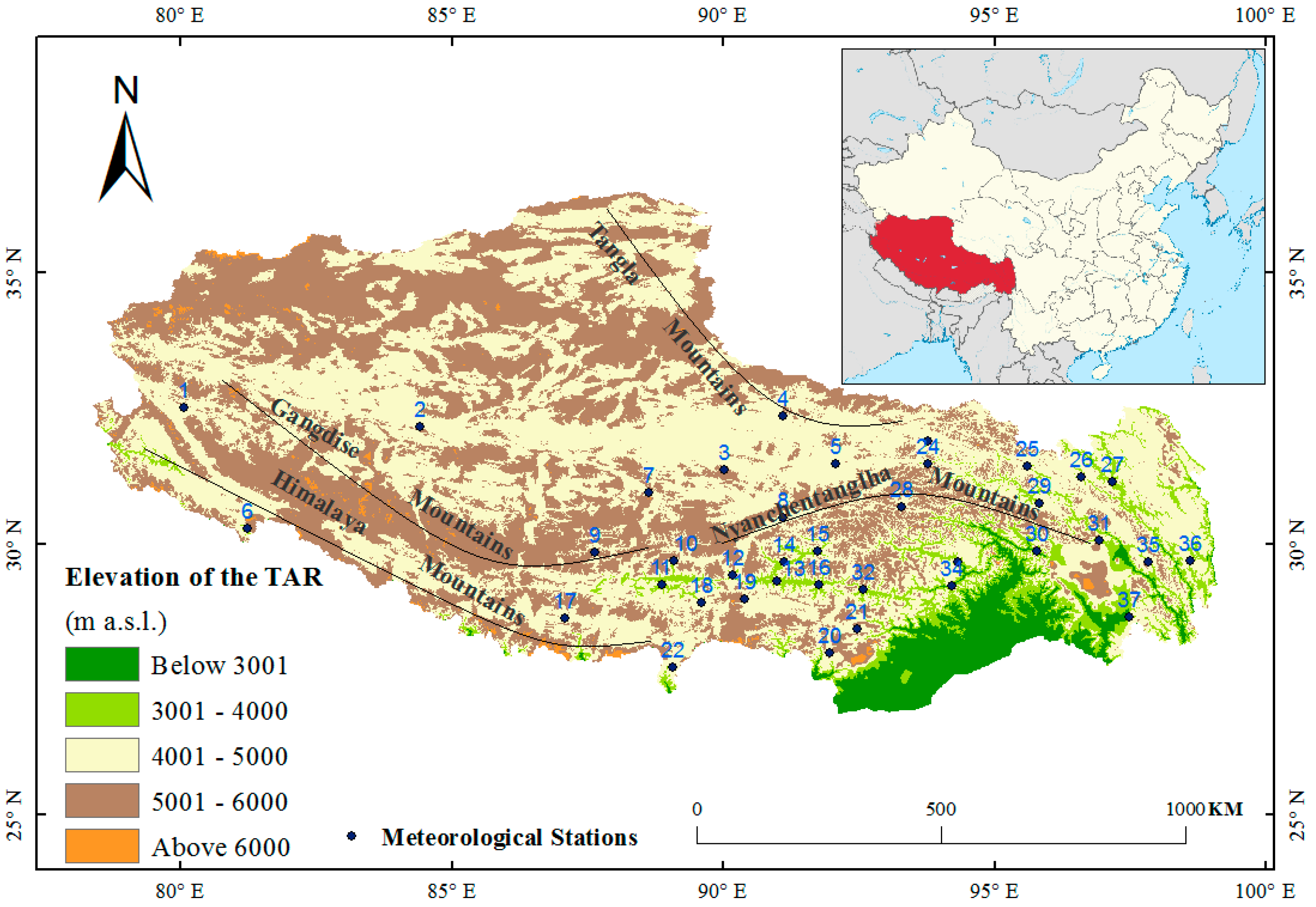

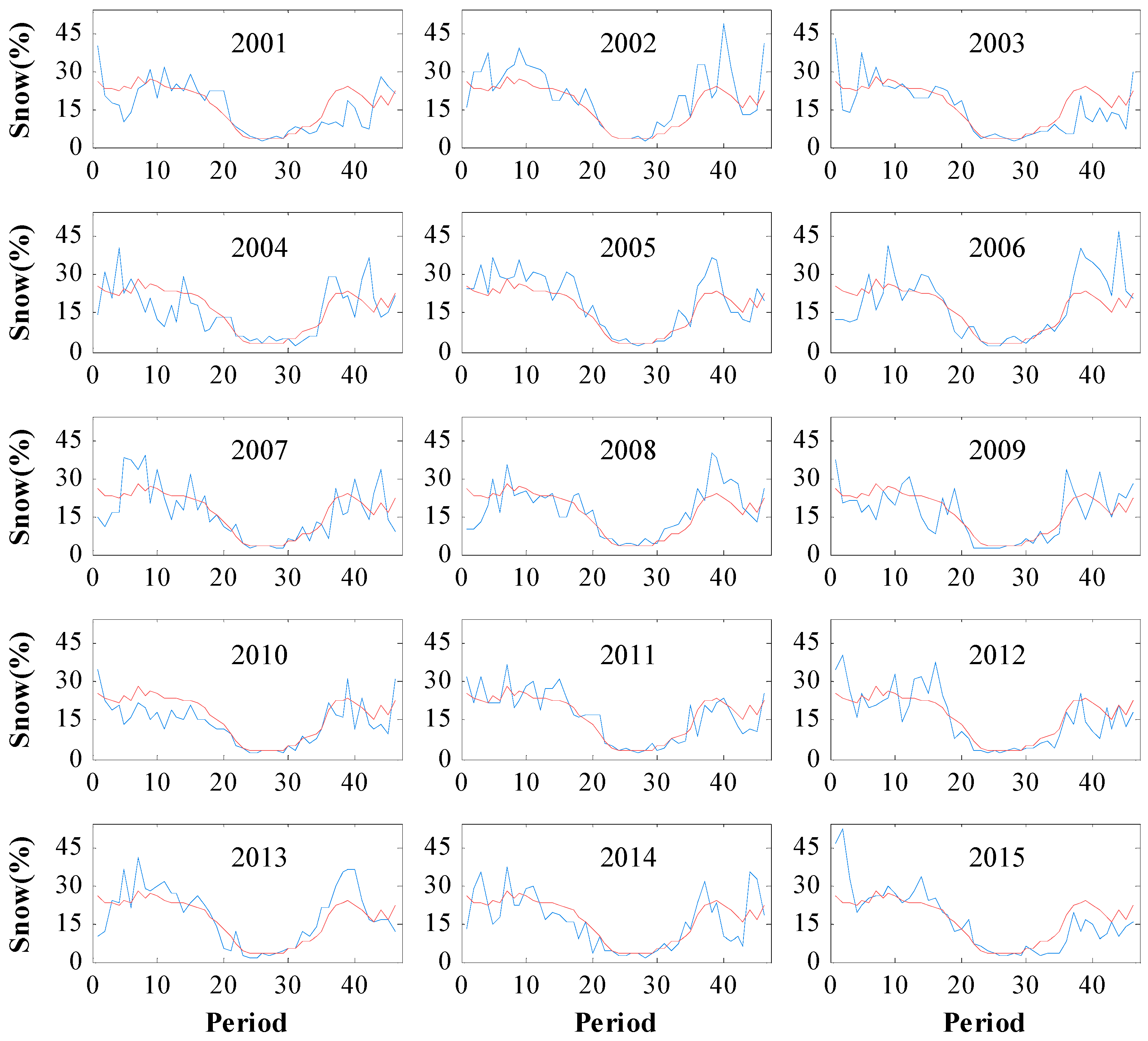
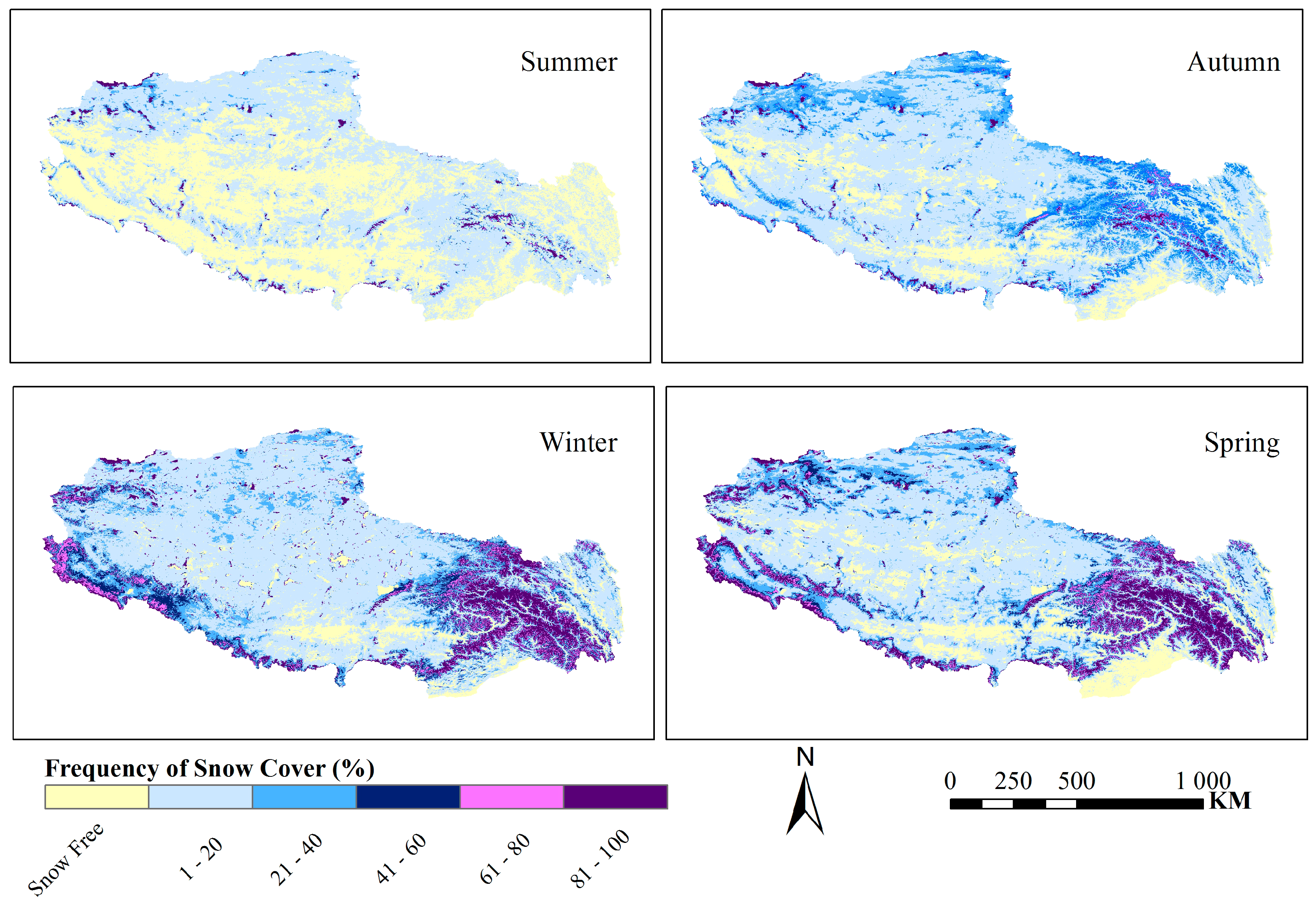
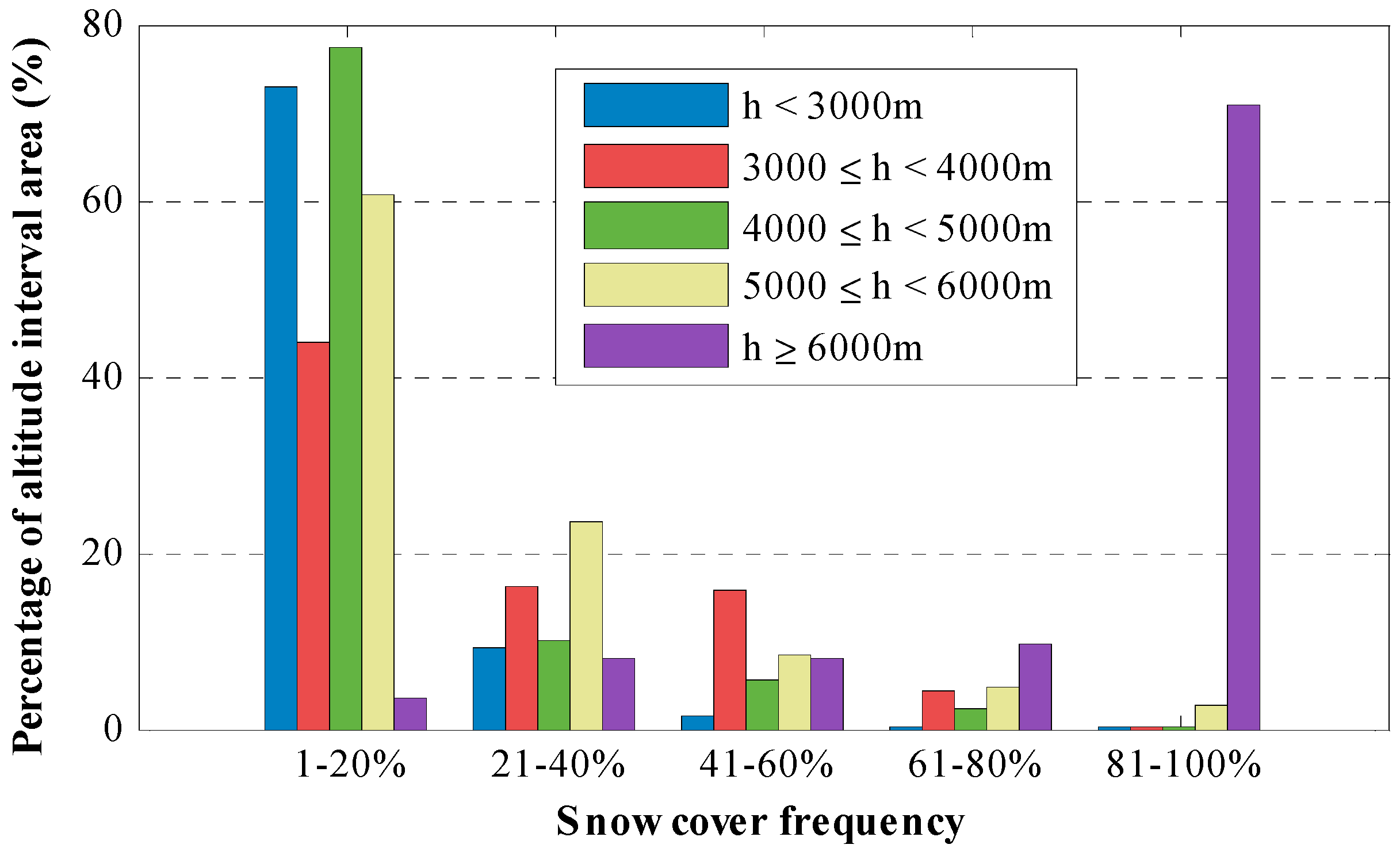
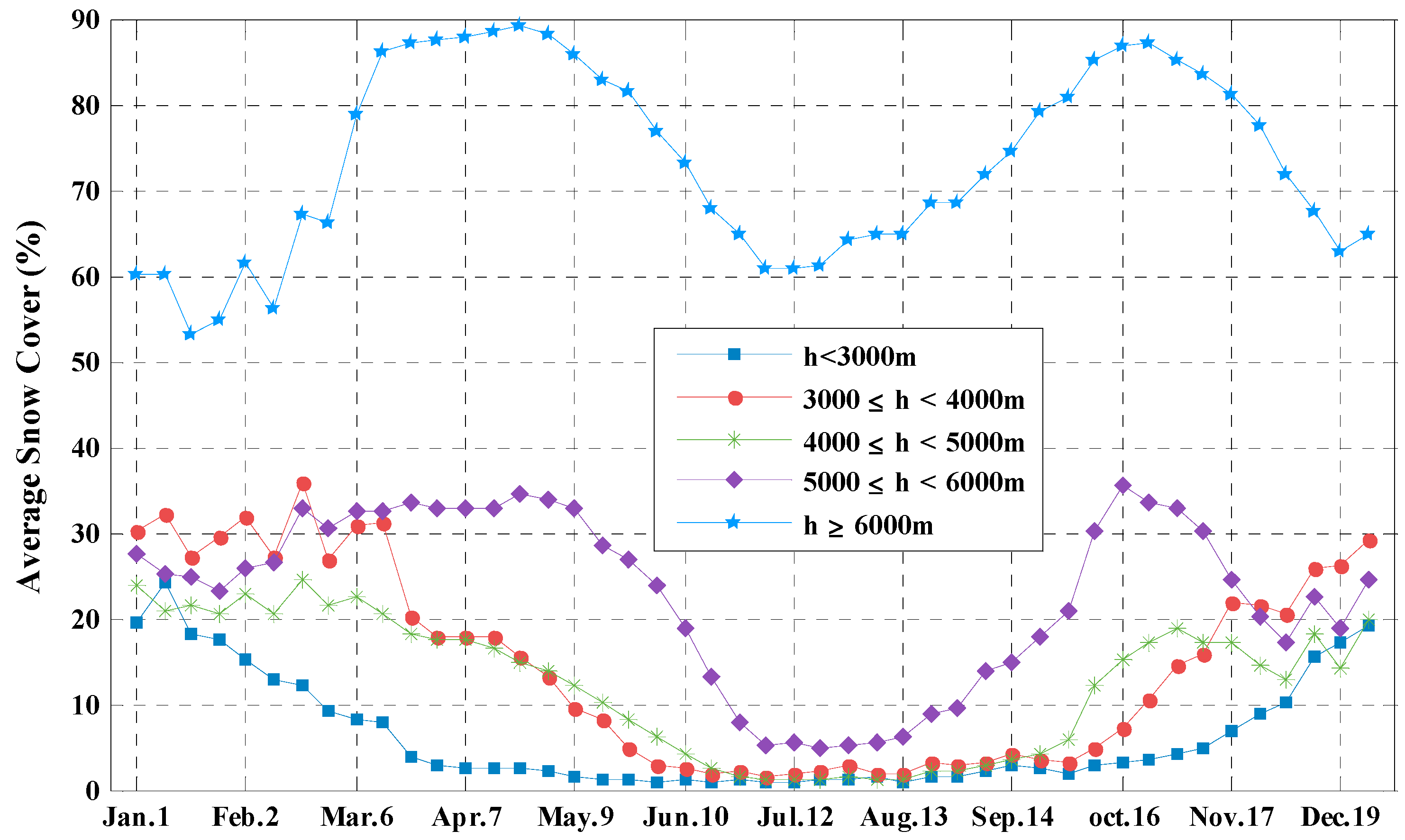
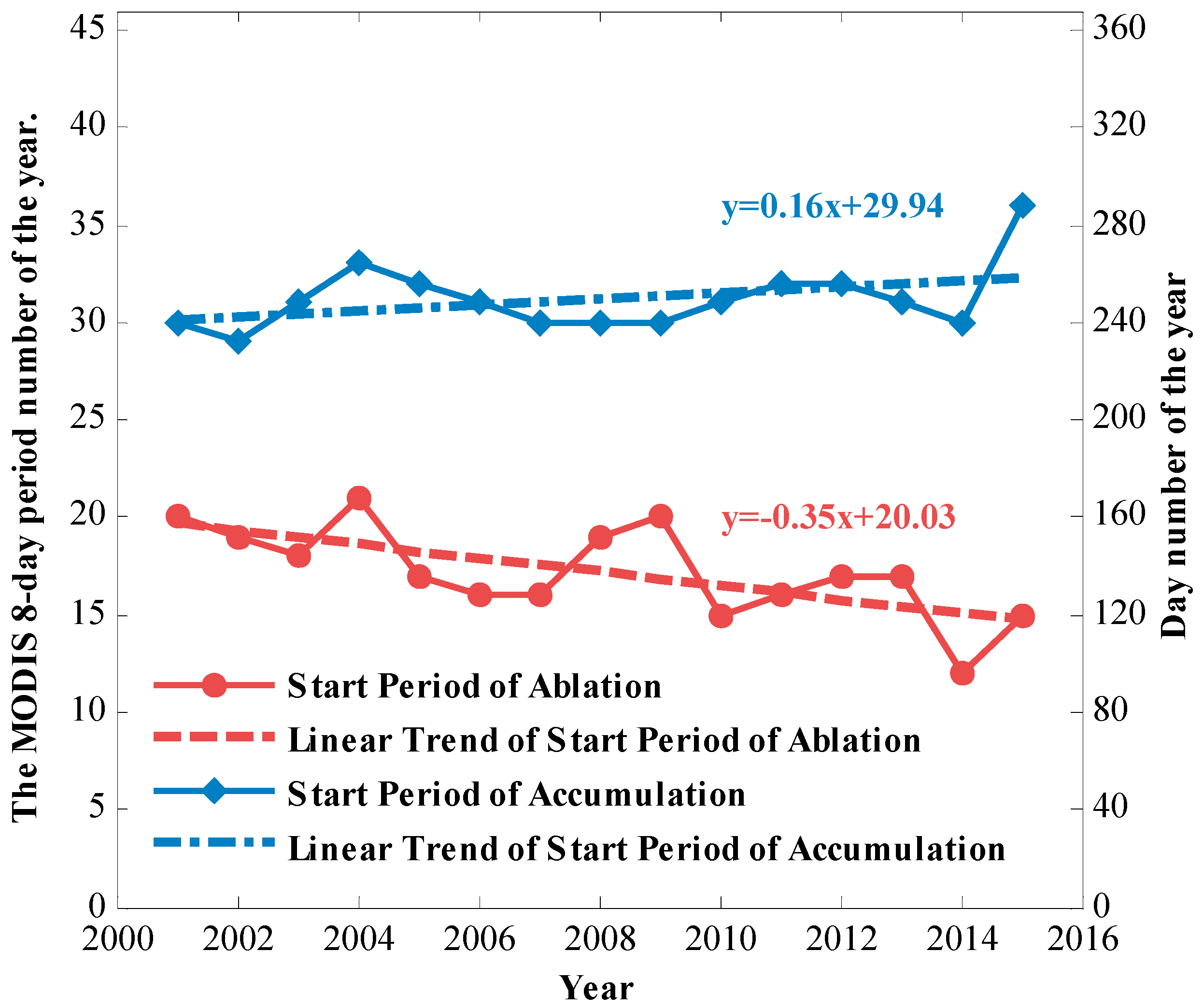

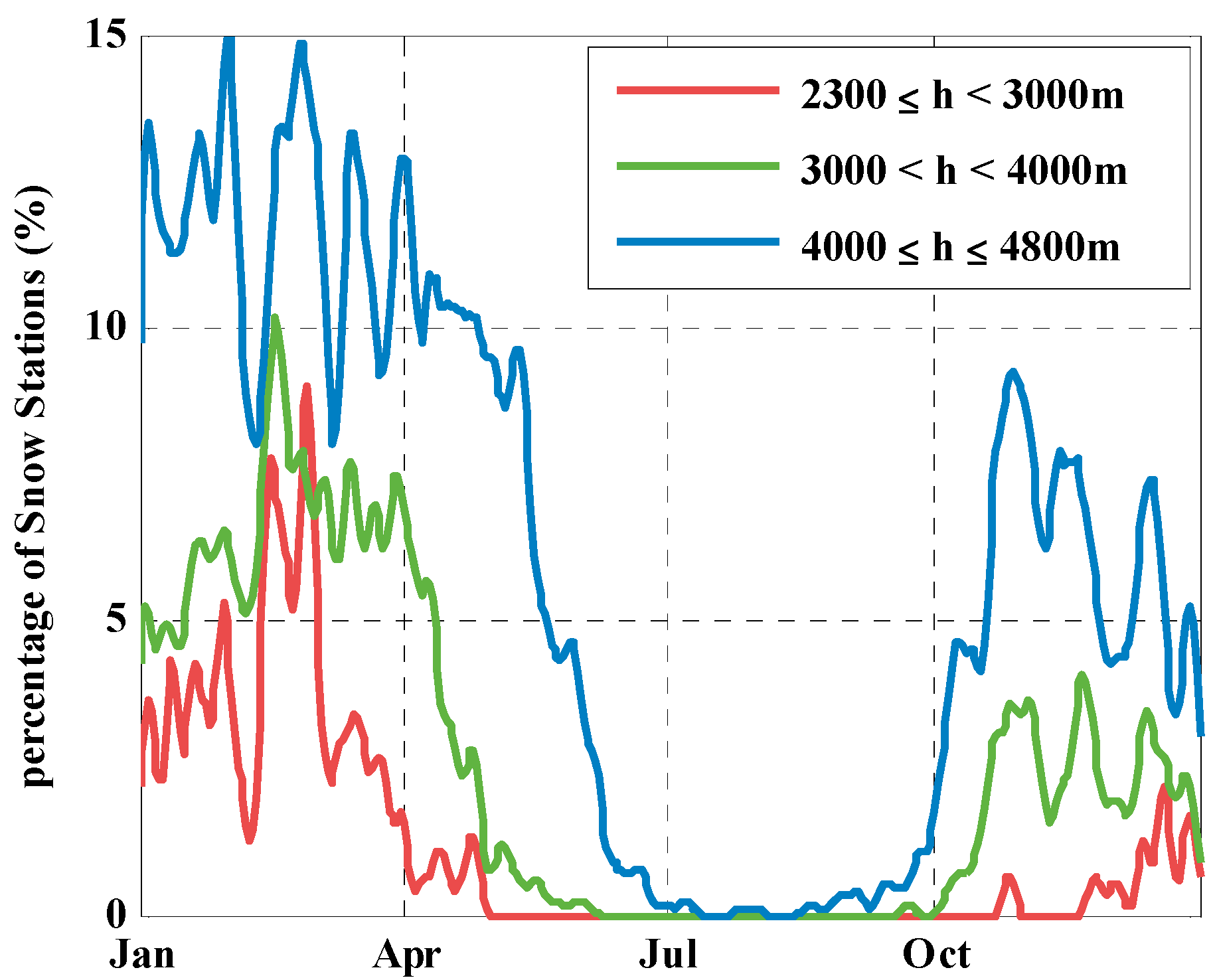
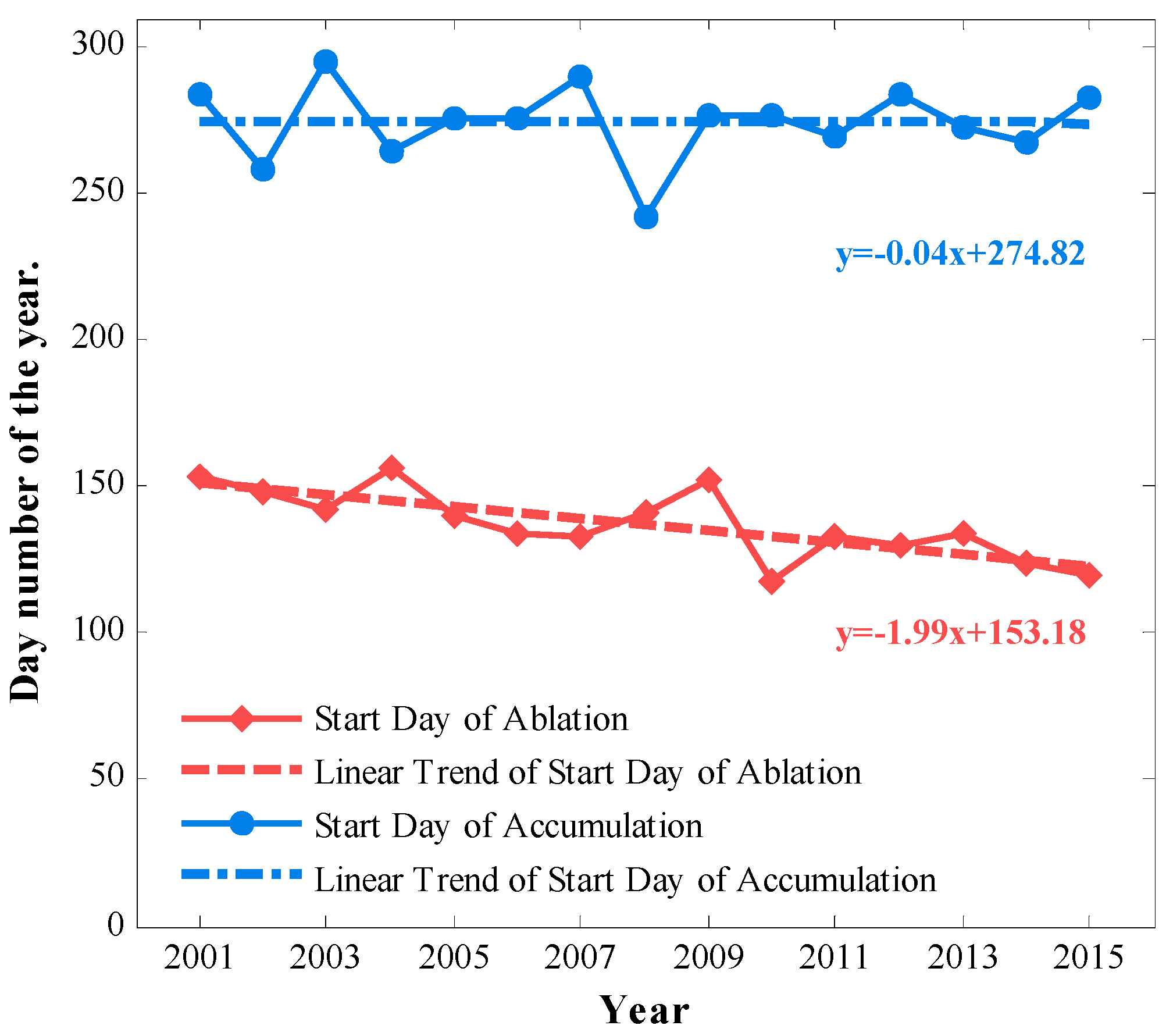
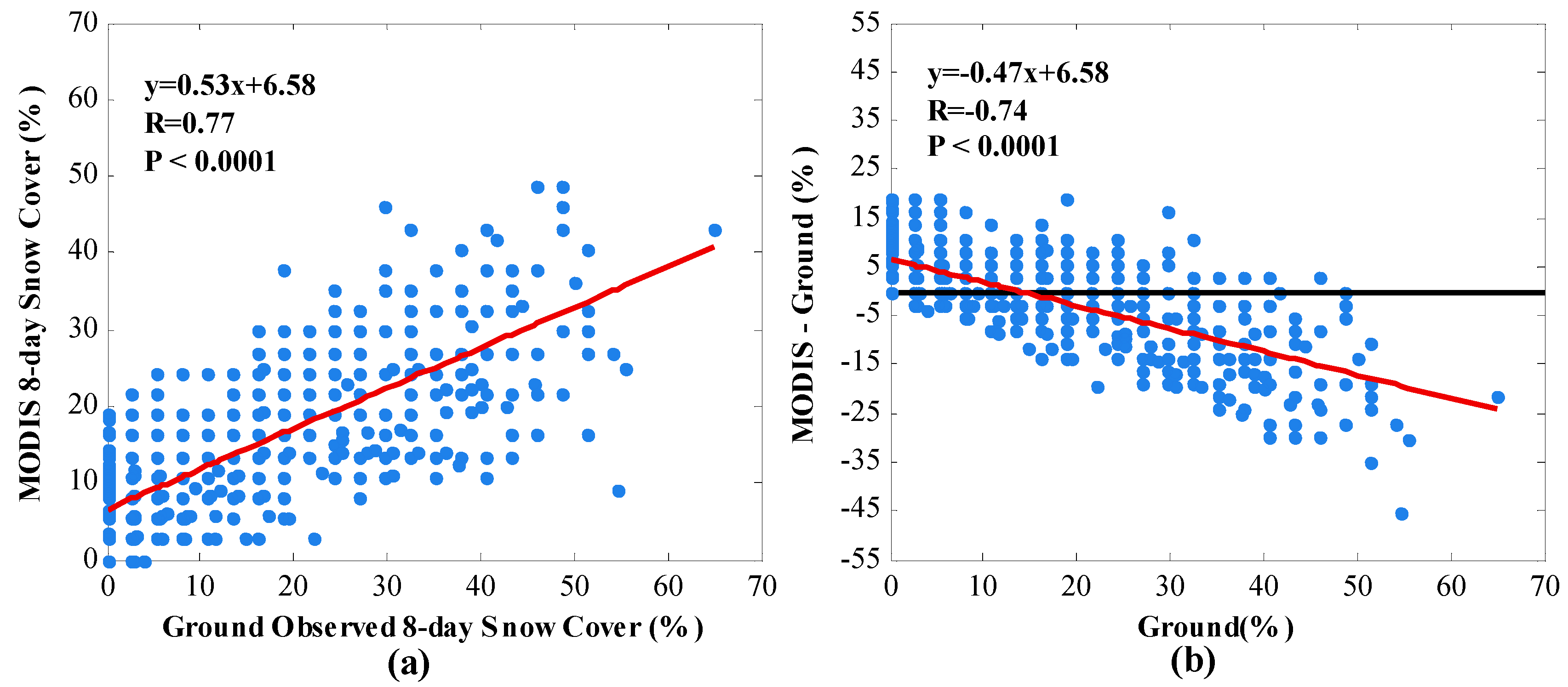
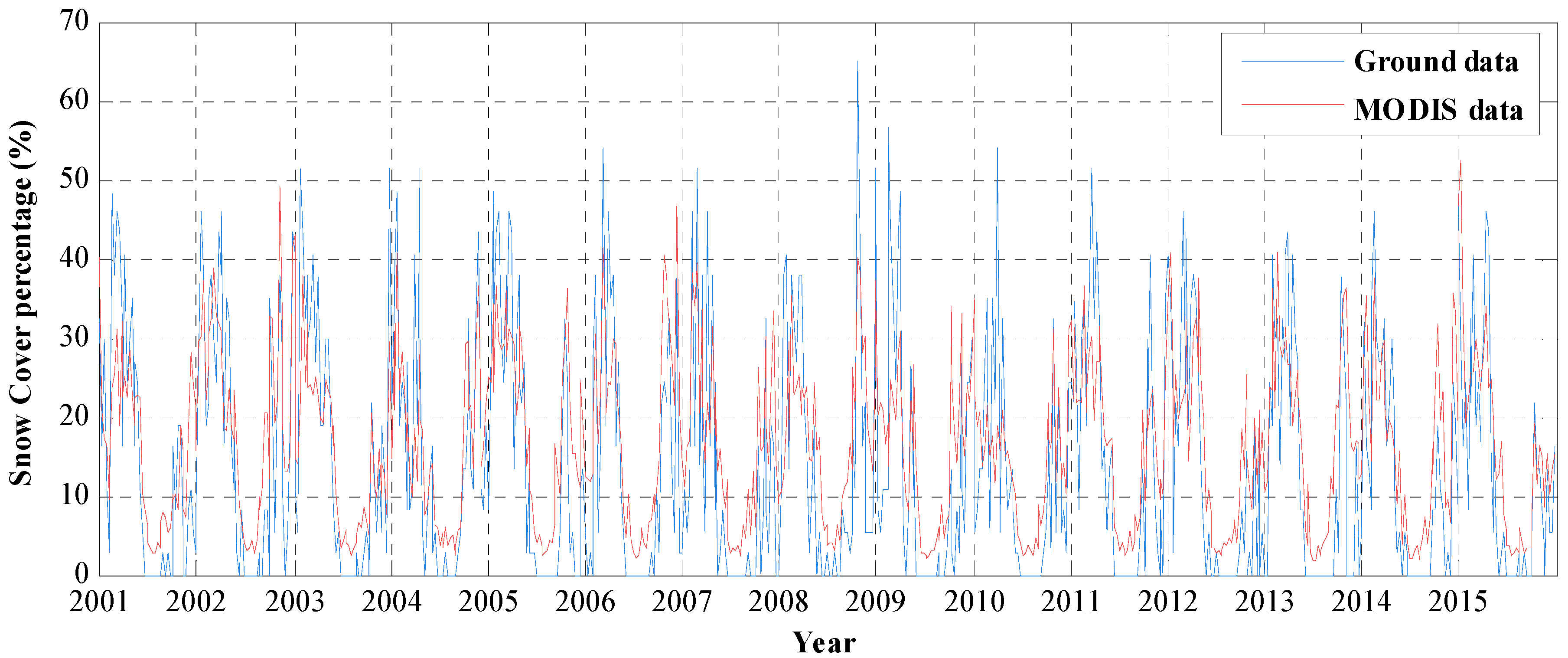
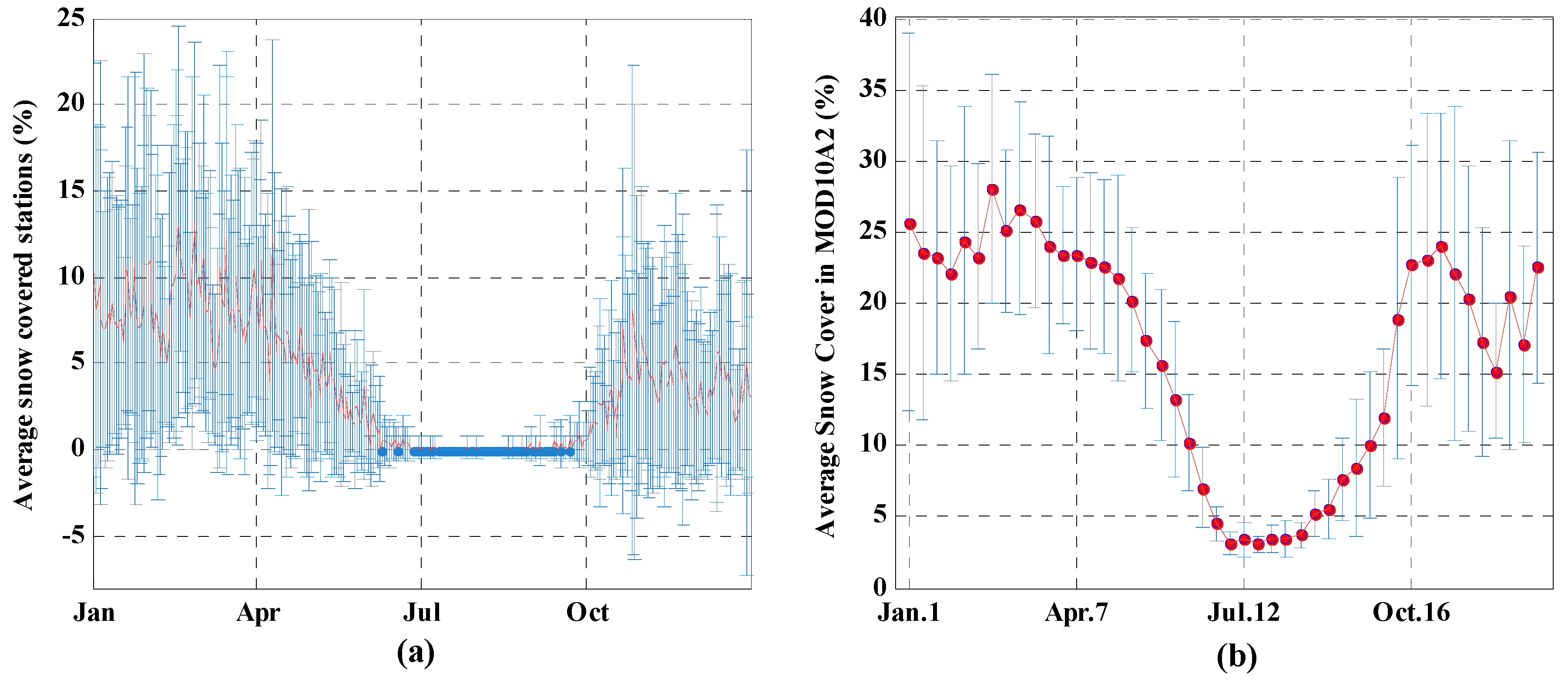
| Frequency Range (%) | Areas (km2) | Percentage of Tibet Area (%) |
|---|---|---|
| Snow Free | 52,416 | 4.2 |
| 1–20 | 856,314 | 68.0 |
| 21–40 | 197,098 | 15.7 |
| 41–60 | 88,441 | 7.0 |
| 61–80 | 44,176 | 3.5 |
| 81–100 | 20,488 | 1.6 |
| Season | Summer | Autumn | Winter | Spring |
|---|---|---|---|---|
| Period | 20–30 | 31–42 | 43–46 & 1–8 | 9–19 |
| Date | 2 June–28 August | 29 August–2 December | 3 December–5 March | 6 March–1 June |
| Frequency | Summer (%) | Autumn (%) | Winter (%) | Spring (%) |
|---|---|---|---|---|
| 0% | 15 | 42 | 32 | 36 |
| 1–20% | 72 | 56 | 65 | 57 |
| 21–40% | 8 | 2 | 2 | 5 |
| 41–60% | 5 | 0 | 1 | 1 |
| 61–80% | 1 | 0 | 0 | 0 |
| 81–100% | 0 | 0 | 0 | 0 |
| Altitude Interval | <3000 m | 3000–3999 m | 4000–4999 m | 5000–6000 m | >6000 m |
|---|---|---|---|---|---|
| Percentage of Tibet | 4.7% | 5.2% | 49.8% | 39.6% | 0.7% |
| Snow covered at least once during 15 years | 4.0% | 4.2% | 47.5% | 39.5% | 0.7% |
| Year | 2001 | 2002 | 2003 | 2004 | 2005 | 2006 | 2007 | 2008 | 2009 | 2010 | 2011 | 2012 | 2013 | 2014 | 2015 |
|---|---|---|---|---|---|---|---|---|---|---|---|---|---|---|---|
| Average | 1.9 | 2.3 | 2.2 | 2.3 | 2.3 | 1.6 | 1.6 | 2.4 | 2.0 | 1.2 | 1.9 | 1.8 | 1.9 | 1.5 | 1.9 |
| Maximum | 11 | 16 | 18 | 18 | 14 | 13 | 14 | 21 | 15 | 11 | 12 | 14 | 11 | 12 | 16 |
| Altitude Interval | 2300–3000 m | 3000–3999 m | 4000–4800 m |
|---|---|---|---|
| Number of stations | 4 | 17 | 16 |
| North Latitude Range | 28.65–29.87 | 28.18–31.48 | 27.73–32.50 |
| East Longitude Range | 94.22–97.47 | 81.25–98.60 | 80.08–93.78 |
| Year | Average (%) | Maximum (%) | Year | Average (%) | Maximum (%) | ||||
|---|---|---|---|---|---|---|---|---|---|
| Station | MODIS | Station | MODIS | Station | MODIS | Station | MODIS | ||
| 2001 | 13.8 | 15.5 | 48.6 | 40.2 | 2009 | 13.4 | 15.9 | 56.8 | 37.4 |
| 2002 | 17.5 | 20.3 | 45.9 | 49.2 | 2010 | 11.8 | 13.8 | 54.1 | 35.1 |
| 2003 | 15.5 | 15.0 | 51.4 | 43.1 | 2011 | 15.4 | 16.6 | 51.4 | 36.5 |
| 2004 | 15.2 | 15.8 | 51.4 | 40.9 | 2012 | 12.1 | 15.9 | 45.9 | 40.7 |
| 2005 | 15.7 | 19.5 | 48.6 | 36.6 | 2013 | 12.6 | 18.0 | 43.2 | 40.8 |
| 2006 | 13.1 | 18.1 | 54.1 | 46.9 | 2014 | 11.6 | 15.5 | 45.9 | 37.7 |
| 2007 | 11.1 | 16.4 | 51.4 | 39.7 | 2015 | 12.7 | 16.1 | 48.6 | 52.3 |
| 2008 | 14.9 | 17.5 | 64.9 | 40.1 | |||||
| Month | Jan. | Feb. | Mar. | Apr. | May | Jun. | Jul. | Aug. | Sep. | Oct. | Nov. | Dec. |
|---|---|---|---|---|---|---|---|---|---|---|---|---|
| Precipitation (mm) | 2.7 | 5.2 | 12.7 | 23.4 | 40.7 | 73.0 | 111.9 | 100.5 | 58.5 | 21.8 | 3.8 | 1.3 |
| Temperature (°C) | −4.3 | −1.9 | 2.0 | 5.3 | 9.2 | 12.9 | 13.7 | 13.0 | 10.6 | 5.3 | −0.1 | −3.1 |
| Year | 2001 | 2002 | 2003 | 2004 | 2005 | 2006 | 2007 | 2008 | 2009 | 2010 | 2011 | 2012 | 2013 | 2014 | 2015 |
|---|---|---|---|---|---|---|---|---|---|---|---|---|---|---|---|
| Ablation | 7 | 4 | 2 | 11 | −4 | −6 | −5 | 11 | 8 | 2 | −5 | 6 | 2 | −28 | 0 |
| Accumulation | −44 | −26 | −47 | −1 | −20 | −28 | −50 | −2 | −37 | −29 | −14 | −28 | −25 | −28 | 5 |
© 2017 by the authors. Licensee MDPI, Basel, Switzerland. This article is an open access article distributed under the terms and conditions of the Creative Commons Attribution (CC BY) license (http://creativecommons.org/licenses/by/4.0/).
Share and Cite
Basang, D.; Barthel, K.; Olseth, J.A. Satellite and Ground Observations of Snow Cover in Tibet during 2001–2015. Remote Sens. 2017, 9, 1201. https://doi.org/10.3390/rs9111201
Basang D, Barthel K, Olseth JA. Satellite and Ground Observations of Snow Cover in Tibet during 2001–2015. Remote Sensing. 2017; 9(11):1201. https://doi.org/10.3390/rs9111201
Chicago/Turabian StyleBasang, Droma, Knut Barthel, and Jan Asle Olseth. 2017. "Satellite and Ground Observations of Snow Cover in Tibet during 2001–2015" Remote Sensing 9, no. 11: 1201. https://doi.org/10.3390/rs9111201





